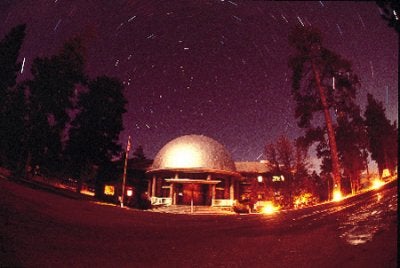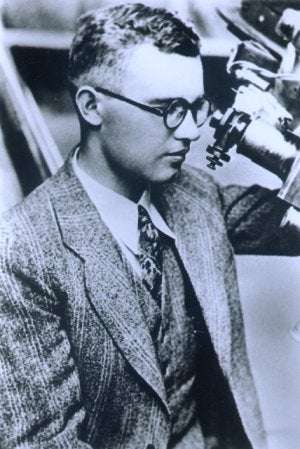Here are just a few contributions to our knowledge of the universe that were made at Lowell Observatory:
Vesto Melvin Slipher spent cold winter nights focusing Lowell Observatory’s 24-inch Clark telescope on the Andromeda Nebula. Percival Lowell had asked Slipher to investigate spiral nebulae because, at the time, astronomers did not understand the nature of these objects. A new, faster lens on the spectrograph camera attached to the scope allowed Slipher to take more-detailed images of the nebula than ever before. This helped him detect that the nebula was moving three times faster than any object known then.
This important discovery fueled Slipher’s curiosity and led him to investigate another spiral nebula in Virgo. His findings in the Virgo cluster showed a redshift of spectral lines. A redshift indicates an object is moving away from an observer. In this case, Slipher discovered the nebula was moving away from Earth at a rate of 2 million miles (3.2 million kilometers) per hour, even faster than the speed he detected from the Andromeda nebula. These results laid the foundation for Edwin Hubble’s famous conclusion that the universe is expanding. Hubble used Slipher’s measurements of galactic redshifts to plot the distance-velocity relationship that finally convinced him — and most astronomers — the universe was indeed expanding.
Percival Lowell is perhaps as famous for his commitment to the existence of “Planet X” as he is for his belief in life and canals on Mars. Lowell himself failed to discover or deduce from mathematical equations the existence of a Planet X. However, one of his apprentices, Clyde Tombaugh, succeeded in discovering the planet Pluto. Using the observatory’s blink comparator to examine plates from observations of the constellation Gemini made on January 23 and 29, Tombaugh detected an object flashing in and out of the background. Tombaugh spent three weeks relocating the object in a telescope, tracking it, and photographing it to confirm his discovery. Fittingly, the announcement was made on the anniversary of Percival Lowell’s 75th birthday, March 13.
Pluto actually was named by an 11-year-old English schoolgirl. Lowell Observatory supported the name and submitted it as the official name for the newly discovered planet. Notice, too, the first two letters of the planet’s name are Percival Lowell’s initials. The primary reason for proposing this name was to continue the tradition of naming planets after Roman gods. Pluto is the god of the underworld, so it is fitting to name the planet located at the farthest reaches of the solar system after him.
This historic discovery of our solar system’s ninth planet marked the only time a planet has been found from an observatory in the United States.
As part of an international team, a group of Lowell astronomers participated in the discovery of nine narrow rings surrounding Uranus. This historic observation was made from the Lowell Observatory telescope at Perth Observatory located east of Perth, Australia. Robert Millis, current director of Lowell Observatory, and Cornell University’s James Elliot benefited from an occultation of a star. Light from a star disappeared and reappeared several times before and after the occultation was supposed to occur. The astronomers concluded that rings around Uranus were the likely — and later confirmed — cause of the star’s disappearing act.
An occultation also contributed to Lowell astronomers’ discovery of an atmosphere on Pluto. Whereas in 1977, when the light from a star appeared and disappeared, astronomers noticed the dimming of a star before it was occulted by Pluto. The dimming could be caused only by a previously undetected atmosphere.
Lowell astronomers began the Lowell Observatory Near-Earth Object Search (LONEOS), a project committed to scouring the sky for asteroids headed for Earth. Since its inception, LONEOS has discovered more than 114 asteroids on a collision course for Earth and more than 15 close-approaching comets. For more information, visit the LONEOS web site.











